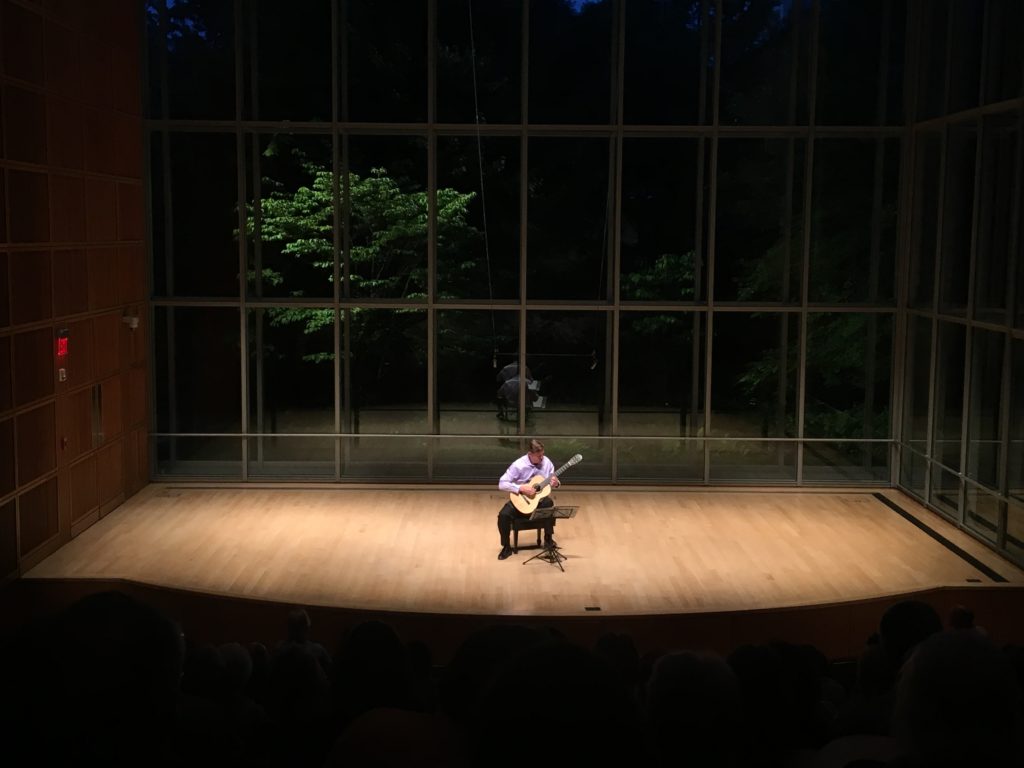by Jarrett Hoffman

Both beautiful and beautifully played was the brief Scarlatti Sonata, K. 208, which opened the program. It also provided a peek at Vieaux’s facile technique, which he would display more as the evening went on.
Giuliani’s Variations on a Theme by Handel, “The Harmonious Blacksmith” was the picture of elegance, Vieaux’s timing, color, and phrasing all subtle and effortless. Like a method actor, you could feel him fully take on the character of each variation as the piece went on. In the minor-key section, he visibly and audibly searched his soul. The fast and joyous variation that followed was like a breath of innocence, and the concluding cadence was nothing if not luxurious.
Vieaux’s performance of Bach’s Violin Sonata No. 1 in g was strong despite a couple of memory slips. He brought an epic, full-bodied sound and some lovely ornamentation to the adagio, while the fugue lived and breathed, and the siciliano was absolutely luminous. Although a bit understated, the finale was still a nice jolt of energy.
Vieaux played from scores during the second half, which began with another of Scarlatti’s lovely slice-of-life sonatas. This one, K. 322, was gracious and intimate, with masterful color changes.
Frank Martín’s 1933 Quatre pièces brèves was something very different, from the long and resonating note with which it begins, and through its surprising, sometimes intense harmonies and its variety of techniques. Vieaux’s strumming was vigorous and electrifying. In the third piece, in a moment that’s straight out of Edgar Allan Poe, those strums keep coming back hauntingly, like something that just won’t stop tapping, tapping at the brain.
Bach closed the program, this time the Cello Suite No. 1. The prelude was flowing and at times appropriately intense. Vieaux’s guitar fell out of tune near the end of the movement, but fortunately he was able to fix it with just a tweak of the instrument between movements, and without interrupting the arc that had only just begun.
The allemande was tender, the courante lively, and the sarabande sounded moonlit. (Speaking of which, Mixon Hall — with its glass wall along the back of the stage — looks even more beautiful after the sun goes down.) Like the presto of the Violin Sonata, here the first menuet and the gigue called for a more outgoing approach to balance the intimacy of the surrounding movements.
Returning to the stage to offer an encore, Vieaux made a surprising discovery: a container of makeup which had apparently been sitting behind him on the stool for the entire recital. “I get that all the time, people throwing eyeshadow at me,” he joked.
Then came his own Rhapsody, written for his parents, who he said had supported him so much. Sweet and nostalgic, with shades of darkness and intriguing harmonies, it’s a definite gem, one that feels personal. It was moving to have him share it with us.
Published on ClevelandClassical.com July 2, 2019.
Click here for a printable copy of this article



